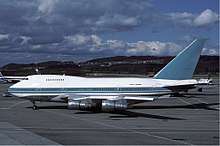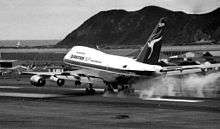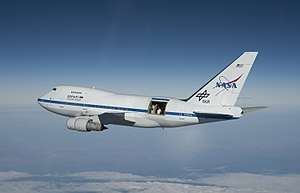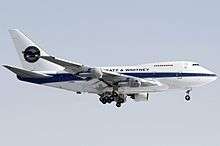Boeing 747SP
| Boeing 747SP | |
|---|---|
 | |
| Boeing 747SP of launch customer Pan American World Airways | |
| Role | Wide-body jet aircraft |
| Manufacturer | Boeing Airplane Company |
| First flight | July 4, 1975 |
| Introduction | 1976 with Pan Am |
| Status | In limited service as governmental, charter or VIP aircraft, one in service as SOFIA. |
| Primary users | Pan Am (historical) South African Airways (historical) Iran Air (historical) China Airlines (historical) |
| Produced | 1976–1989 |
| Number built | 45[1] |
| Developed from | Boeing 747-100 |
| Variants | SOFIA |
The Boeing 747SP is a version of the Boeing 747 jet airliner which was designed for ultra-long-range flights. The SP stands for "Special Performance". The 747SP is similar to the 747-100 except for the shortened fuselage, larger tailplane, and simplified trailing edge flaps. The weight saved by the shorter fuselage permitted longer range and increased speed relative to other 747 configurations[2] at the time.
Known during development as the short-body 747SB, the 747SP was designed to meet a 1973 joint request from Pan American World Airways and Iran Air, who were looking for a high-capacity airliner with sufficient range to cover Pan Am's New York–Middle Eastern routes and Iran Air's planned Tehran–New York route. The aircraft also was intended to provide Boeing with a mid-size wide-body airliner to compete with existing trijet airliners.
The 747SP entered service with Pan Am in 1976. The aircraft was later acquired by VIP and government customers. The 747SP set several aeronautical performance records, but sales did not meet the expected 200 units, and 45 aircraft were ultimately produced.[3]
Development
The idea for the 747SP came from a request by Pan Am for a 747 variant capable of carrying a full payload non-stop on its longest route between New York and Tehran.[4] Joined with Pan Am's request was Iran Air; their joint interest was for a high capacity airliner capable of covering Pan Am's New York–Middle Eastern routes and Iran Air's planned New York-Tehran route.[5] (New York to Tehran may have been the longest non-stop commercial flight in the world for a short time, until Pan Am started Tehran to New York in mid-1976.) The aircraft was launched with Pan Am's first order in 1973 and the first example delivered in 1976.[6]
A shorter derivative of the 747-100, the SP was developed to target two market requirements.[6] The first was a need to compete with the DC-10 and L-1011 while maintaining commonality with the 747,[6] which in its standard form was too large for many routes. Until the arrival of the 767, Boeing lacked a mid-sized wide-body to compete in this segment. The second market requirement was an aircraft suitable for the ultra-long-range routes emerging in the mid-1970s following the joint request. These routes needed not only longer range, but also higher cruising speeds. Boeing could not afford to develop an all-new design, instead opting to shorten the 747 and optimize it for speed and range, at the expense of capacity.[2]
Originally designated 747SB for "short body", it later was nicknamed "Sutter's balloon" by employees after 747 chief engineer Joe Sutter.[7] Boeing later changed the production designation to 747SP for "special performance", reflecting the aircraft's greater range and higher cruising speed.[8] Production of the 747SP ran from 1976 to 1983. However, a VIP order[6] for the Royal Flight of Abu Dhabi led Boeing to produce one last SP in 1987. Pan Am was the launch customer for the 747SP, taking the first delivery, Clipper Freedom, on March 5, 1976.[8]
The 747SP was the longest-range airliner available until the 747-400 entered service in 1989. Despite its technical achievements, the SP never sold as well as Boeing hoped.[6] Increased fuel prices in the mid-1970s to early 1980s, the SP's heavy wings, expensive cost,[6] reduced capacity, and the increased ranges of forthcoming airliners[6] were some of the many factors that contributed to its low sales. Only 45 were built and of those remaining, most are used by operators in the Middle East. However, some of the engineering work on the 747SP was reused with the development of the 747-300 and 747-400. In the 747SP, the upper deck begins over the section of fuselage that contains the wingbox, not ahead of the wingbox (as is the case with the 747-100 and 747-200). This same design was used in the 747-300 and newer, resulting in a stretched upper deck.
A special 747SP is the Stratospheric Observatory for Infrared Astronomy (SOFIA) astronomical observatory,[6] which had its airframe modified to carry a 2.5-meter-diameter reflecting telescope to high altitude, above 99.9% of the light-absorbing water vapor in the atmosphere. The telescope and its detectors cover a wide wavelength range from the near infrared to the sub-millimeter region; no window material is transparent over this whole range, so the observations are made through a 13 ft (3.96 m) square hole in the port upper quarter of the rear fuselage, aft of a new pressure bulkhead. A sliding door covers the aperture when the telescope is not in use.[9] Astronomers take data and control the instrument from within the normally pressurised cabin. Originally delivered to Pan Am and titled "Clipper Lindbergh", NASA has the name displayed in script on the port side of the aircraft.
Design
Apart from having a significantly shorter fuselage and one fewer cabin door per side, the 747SP differs from other 747 variants in having simplified flaps and a taller vertical tail[6] to counteract the decrease in yaw moment-arm from the shortened fuselage. The 747SP uses single-piece flaps on the trailing edges, rather than the smaller triple-slotted flaps of standard 747s.
The SP could accommodate 230 passengers in a 3-class cabin or 331 in a (303 economy, 28 business) 2-class cabin, and a maximum of 400 passengers in one class.
Operators


Deliveries
Forty-five 747SP aircraft were built between 1974 and 1989 with two more planned but never constructed.[10] The production line was ended in 1982 but reopened in 1987 to fulfill an order for the United Arab Emirates.[11]
| Type | 1976 | 1977 | 1978 | 1979 | 1980 | 1981 | 1982 | 1983 | 1984 | 1985 | 1986 | 1987 | 1988 | 1989 | Total |
|---|---|---|---|---|---|---|---|---|---|---|---|---|---|---|---|
| 747-SP | 14 | 4 | 2 | 5 | 9 | 6 | 4 | 1 | 45 |
Current operators
As of December 2016, there were 10 Boeing 747SPs still in active service with 9 more stored and 1 preserved. The remaining 25 were either scrapped, otherwise destroyed or abandoned.[10] In 2016, the last 747SP in commercial service was withdrawn from service after 40 years by Iran Air.[12][13][14] As of 2017, the majority of the ten aircraft still in service are used for governmental or VIP transport.
- 2 Government of Saudi Arabia (painted in Saudia livery)
- 2 Pratt & Whitney Canada (used as an engine testbed)[15]
- 1 Pratt & Whitney
- 1 Ernest Angley Ministries
- 1 NASA Armstrong Flight Research Center
- 1 Government of Bahrain
- 1 Government of Oman
- 1 Government of Qatar
- 2 Las Vegas Sands
- 1 NASA/DLR (used as the Stratospheric Observatory for Infrared Astronomy, SOFIA)
Aircraft on display
- An ex-South African Airways 747SP nicknamed "Maluti" is on static display at Rand Airport in South Africa, where it is maintained by the South African Airways Museum Society.
Former operators





This list also includes organizations that used the aircraft temporarily, besides main operators.
Africa
America
Asia
Europe
Oceania
Records
There were three significant commercial around-the-world record-setting flights flown by 747SP: two operated by Pan Am and the other operated by United Airlines with the aircraft being "loaned" to Friendship Foundation, in order to raise money for the foundation. Those flights are:
- Liberty Bell Express[6]—Flown from New York/JFK May 1–3, 1976. 2 stopovers at Indira Gandhi International Airport, New Delhi and Tokyo-Haneda Airport. The round-the-world flight took 46 hours and 26 minutes over 23,137 miles.[6]
- Pan Am Flight 50—to celebrate the 50th anniversary of Pan Am. Flown October 28–30, 1977 from San Francisco/SFO, with a time duration of 54 hours, 7 minutes, 12 seconds. 3 stopovers at London-Heathrow Airport, Cape Town International Airport and Auckland Airport. Flight 50 flew over both the North Pole and the South Pole.
- Friendship One[6]—Flown January 29–31, 1988 from Seattle/SEA, to raise funds for Friendship Foundation. Two stopovers were made, at Athens Airport and Taipei-Taiwan Taoyuan International Airport (formerly the Chiang Kai-shek International Airport). The record lasted less than a month, as it was beaten by a Gulfstream IV piloted in part by Gulfstream Aerospace CEO Al Paulson. The round-the-world flight took 35 hours and 54 minutes over 23,125 miles.[6]
Incidents and accidents
- On February 19, 1985, China Airlines Flight 006, a 747SP-09 (aircraft registration N4522V) with 274 passengers and crew on board on a flight from Chiang Kai-shek Airport to Los Angeles International Airport suffered an inflight failure on engine number four. While the flight crew attempted to restore power the aircraft rolled to the right and started a steep descent from the cruising altitude of 41,000 feet, pulling 4.8 G and 5.1 G on two occasions. The captain managed to stabilize the aircraft at 9,500 feet and the aircraft diverted to San Francisco International Airport which was 550 km (343.8 mi.) away. Two passengers were injured and the aircraft suffered major structural damage.[46]
- On October 5, 1998 a South African Airways Boeing 747SP-44 (ZS-SPF) operated by LAM Mozambique Airlines suffered an engine failure shortly after take-off from Maputo International Airport, Mozambique. The no. 3 engine suffered an uncontained failure – flying debris caused damage to the no. 4 engine and the wing. A fire broke out that couldn’t be extinguished immediately, forcing an emergency landing. All 66 people on board survived. As a result the aircraft was withdrawn from service and scrapped.[19]
- During the Yemeni Civil War (2015-Present), a 747SP owned by the President of Yemen, 7O-YMN, was struck by gunfire on March 19, 2015. Subsequent photographs show that the aircraft was then completely destroyed by fire afterwards.
Specifications
| Model | 747SP[47] |
|---|---|
| Cockpit crew | 3 (2 pilots, flight engineer)[48] |
| Seating capacity | 331 (28F + 303Y)[47] or 343 (30F + 313Y)[49] 276 (25F + 57J + 194Y)[49] |
| exit limit | 400[48] |
| Overall length | 184 ft 9 in (56.31 m) |
| Wingspan | 195 ft 8 in (59.64 m) |
| Wing area | 5,500 ft² (511 m²)[50] |
| Overall height | 65 ft 10 in (20.06 m) |
| Operating empty weight | 325,260–336,870 lb (147,690–152,780 kg) |
| Maximum take-off weight | 696,000 lb (315,600 kg) |
| Engine models (x 4) | PW JT9D-7(A/AH/F/FW/J) RR RB211-524(B2/C2/D4) |
| Engine thrust (x 4) | PW 46,950–50,000 lbf (208.8–222.4 kN) RR 50,000–53,000 lbf (220–240 kN) |
| Maximum speed | Mach 0.92 (542 kn; 1,004 km/h)[51] |
| Cruising speed | Mach 0.86 (493 kn; 914 km/h)[51] |
| Service ceiling | 45,100 feet (13,700 m)[51] |
| Maximum range | 5,830 nmi (10,800 km; 6,710 mi)[lower-alpha 1][49] |
| Max Fuel capacity | 50,360 USgal (190,610 l) |
Note
- ↑ JT9D, 276 passengers
See also
Related development
Aircraft of comparable role, configuration and era
Related lists
References
- ↑ "747 Model Summary". Boeing. Retrieved December 29, 2010.
- 1 2 "The Boeing 747 Classics". Boeing Commercial Airplanes. Boeing. Retrieved 2009-01-23.
Boeing also built the 747-100SP (special performance), which had a shortened fuselage and was designed to fly higher, faster and farther non-stop than any 747 model of its time. \
- ↑ Norris & Wagner 1999, p. 20
- ↑ Eden, Paul. (Ed). Civil Aircraft Today. 2008: Amber Books, pp. 92–3.
- ↑ Jenkins 2000, p. 76.
- 1 2 3 4 5 6 7 8 9 10 11 12 13 Eden 2008, pp. 96–7.
- ↑ Sutter, Joe (2006). 747: Creating the world's first jumbo jet and other adventures from a life in aviation. HarperCollins. p. 218. ISBN 0-06-088241-7.
- 1 2 Norris, Guy (1997). Boeing 747: Design and Development Since 1969. Motorbooks International. p. 74. ISBN 0-7603-0280-4.
- ↑ "NAS's new airborne observatory". Sky and Telescope. 120 (4): 22–28. October 2010.
- 1 2 747sp.com – Production List retrieved 4 June 2016
- ↑ "The Story of the B747SP." 747sp.com. Retrieved: July 14, 2017.
- ↑ Chini, Amin. "Iran Air Grounds Boeing 747SP, Suspends Kuala Lumpur Service (Jun 21, 2016)". AviationIran.com. Retrieved 1 January 2017.
- ↑ "Production List – airframe 21093". 747SP.com. Retrieved 1 January 2017.
- ↑ "Review: Farewell Iran Air B747-SP Tehran to Mumbai". Sam Chui Aviation & Travel. Retrieved 1 January 2017.
- ↑ MRJ Geared Turbofan Starts Flight Tests On 747SP. Aviationweek.com.
- 1 2 3 4 5 6 7 "Operators". Boeing 747SP Website.
- ↑ Kinshasa Airways 747SP. Airliners.net (November 3, 2003).
- ↑ Ben R. Guttery (1998). Encyclopedia of African Airlines. McFarland & Company. p. 125. ISBN 978-0-7864-0495-7.
- 1 2 "Boeing 747SP". Zap16.com. Retrieved December 30, 2010.
- ↑ Air Namibia 747SP. Airliners.net.
- ↑ Alliance 747SP. Airliners.net.
- ↑ Avia 747SP. Airliners.net (January 3, 2006).
- ↑ "Boeing 747SP Maluti ZS-SPC". SAA Museum. 2012. Retrieved January 4, 2012.
- ↑ The Boeing 747SP of Trek Airways. Trekairways.co.za (September 4, 1993).
- ↑ Argentinas 747SP. Airliners.net (January 5, 2012).
- ↑ "Airfleets aviation – Airline Fleet, plane, airport : Boeing Airbus Embraer Atr Fokker Dash Beechcraft]". airfleets.net.
- ↑ "Vintage Airline Seat Map: American Airlines Boeing 747SP". Frequently Flying. Retrieved September 11, 2015.
- ↑ http://www.braniffinternational.org/aircraft/747sp.htmArchived+August+31,+2006,+at+the+Wayback+Machine.
- ↑ Mercury Star News: Ballet's Head-turning Move, Fry's Owner Loans Decorated 747 For S.J. Dancers' Tour. Nl.newsbank.com (November 21, 2007).
- ↑ 1977/78: PanAm Routes. Airline Route (December 19, 2008).
- ↑ 1992/93: UNITED International Network. Airline Route.
- ↑ ch-aviation.com – Iran Air retires the B747SP from service 26 November 2014
- ↑ Iraqi 747SP. Airliners.net (September 7, 2011).
- ↑ Kazakhstan Airlines 747SP. Airliners.net (September 4, 1994).
- ↑ "Qatar Airways Fleet Details and History". planespotters.net. Archived from the original on August 23, 2017. Retrieved September 12, 2017.
- ↑ Mandarin Airlines will make maiden flight to Australia Archived June 1, 2012, at the Wayback Machine.. None.
- ↑ Saudi Arabian Airlines – History of the 80's. Saudiairlines.com.
- ↑ Syrian Air 747s status at January 2012. Ch-aviation.ch.
- ↑ Tajik Air 747SP. Airliners.net.
- ↑ "Soldiers loyal to Yemen's former president storm Aden airport". The Guardian. Associated Press in Aden. 19 March 2015.
- ↑ Tommy Mogren (April 6, 2015). "Yemenia 747SP damaged during attacks". B747SP Website.
- ↑ Gulf News (July 17, 2015). "Aden may tilt scales in conflict" (PDF). Gulf News.
- ↑ "21263 / 301 - Production List - Boeing 747SP Website". www.747sp.com.
- ↑ "Red, White And Q Farewell For Qantas Aircraft". Qantas. March 4, 2002. Retrieved 2008-06-04.
- ↑ "QFOM – Qantas 747 VH-EBQ". Qantas Founders Museum. Archived from the original on December 9, 2011. Retrieved January 4, 2012.
- ↑ Aviation Safety Network report – 19 February 1985 accident. Aviation-safety.net.
- 1 2 "747 Airplane Characteristics for Airport Planning" (PDF). Boeing Commercial Airplanes. May 2011.
- 1 2 "Type Certificate Data Sheet" (PDF). FAA. February 27, 2015.
- 1 2 3 "747-100/-200/-300/-SP" (PDF). Boeing. 2007.
- ↑ "Boeing 747SP". Airliners.net.
- 1 2 3 Gregory Maxwell (January 13, 2014). "The Life and Times of the Boeing 747SP".
Further reading
- Davies, R.E.G. (2000). TWA : an airline and its aircraft. McLean, Virginia: Paladwr Press. ISBN 1-888962-16-X.
- Jenkins, Dennis (2000). Boeing 747-100/200/300/SP (AirlinerTech Series, Vol. 6). North Branch, Minnesota: Specialty Press. ISBN 1-58007-026-4.
- Norris, Guy; Wagner, Mark (1999). Modern Boeing Jetliners. Osceola, Wisconsin: Zenith Imprint. ISBN 0-7603-0717-2.
- Baum, Brian (1997). Boeing 747SP. Miami, Florida: World Transport Press. ISBN 0-9626730-7-2.
External links
![]()